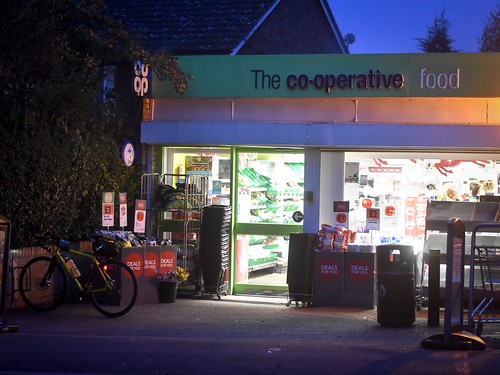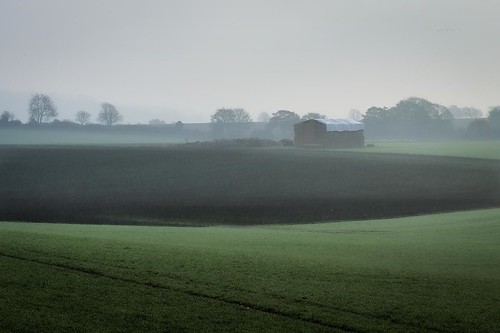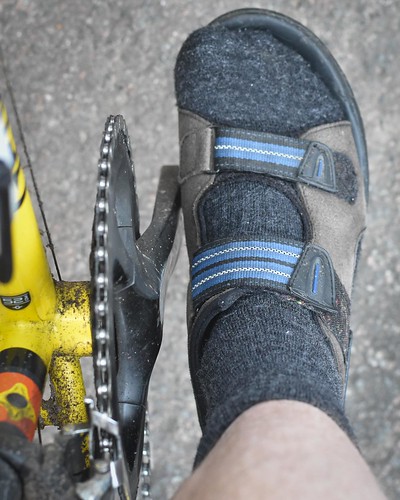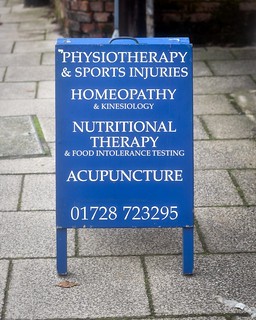I had to ride an audax in November to keep my RRtY attempt alive. With the month drawing to an end and reasonable weather in prospect and I chose the "Cambridge Markets", one of Nick Wilkinson's excellent series of permanent Audax routes from Cambridge.
 The Départ: Co-op in Girton
The Départ: Co-op in GirtonAnd so at 07:13 I found myself setting off from Girton through the Cambridge traffic, which was more than usually clogged because of the sinkhole in the centre of town. However, this did not impede my progress and before long I was at Quy ready to join the busy A1303 towards Newmarket. Because of the heavy rush hour traffic I turned on a large red rear flashing light, which felt – on an audax – mildly transgressive.
By the time I reached Newmarket day had broken. I left town along the familiar road beside the gallops and continued east through Moulton and Gazeley. Although some watery sunshine was struggling to break through the overall picture was a cloudy one, and would remain so for the rest of the day.
 Muted near Moulton
Muted near MoultonAs I got deeper into the countryside the temperature dropped, at one point (according to my Garmin) touching zero. I became conscious I has committed a clothing error: open-toed sandals were not appropriate footwear today, even with thick wool socks.
 Just too cool
Just too coolOtherwise I was mostly happy with my equipment choices today. This was the first outing of my winter bike since January: it's a steel frame (a 2015 Genesis Equilibrium) with disc brakes (TRP Hy/Rd) and sturdy-ish tyres (Hutchinson Sector 28). Since the forecast was dry I hadn't made the effort to re-fit mudguards – more feelings of audax transgression.
Before long I reached Bury St Edmunds and wheeled my bike through the crowded market in search of a cashpoint that was working. As part of my training for LEL I am wanting to get used to riding longish (100km) stages without a proper food stop, so after getting a cashpoint slip, I swiftly re-mounted my bike and pressed on eastward.
The easternmost point of this course is Framlingham, but rather than take a direct route there, Nick routes via a control at Needham Market. I had been here once before on the Green & Yellow Fields audax, but forgot the layout of the town and managed to ride past the shops, necessitating some annoying backtracking. I'm not normally an impatient person, but it seems the further one gets into the country, the longer shop transactions take. The gentleman in front of me at the post office was keen to make a contactless purchase for the first time, then to get some cashback, then – on impulse – buy a scratch card and then buy some stamps that had been forgotten in the former contactless excitement. Argh.
There's some slightly rough lane work after Needham Market – otherwise this route is mostly on fine roads making it suitable for a winter audax. Around here my Garmin decided to switch itself off (it did this again later too). The current firmware for the Edge 1000 seems particularly flaky. At one point the mystery of Garmin/phone integration led it to announce to me simply "Message from 0" ! It's shocking how a supposedly market-leading product is still so poor.
I arrived in Framlingham at around 12:15 and headed into Paddy & Scott’s café for lunch: a sausage roll, cup of tea and carrot cake.
 Framlingham: They still believe in magicke here it seems
Framlingham: They still believe in magicke here it seemsApart from a flapjack bar I munched on the bike through the ride, this would be all the food I was to eat, which, as it turned out, was plenty.
 Half of lunch
Half of lunchAfter lunch I started back west towards Cambridge. The return route didn't go via Needham Market but took a more direct route via Debenham and Elmswell. This was perhaps my favourite section of the ride, on gently rolling smooth roads through green open country.
Back at Bury I got a cashpoint slip and looked up to see Starbucks. Perhaps I deserved a cake and coffee? (or at least the hot milky stuff one typically gets from Starbucks). But no, I stiffened my resolve and rode off west in the gathering gloom.
As darkness fell I reflected on the fact I'd been on the ride for nearly 10 hours with my only human contact a few brief businesslike exchanges with shop assistants. I seem to be able to tolerate my own company and happily while away solo hours a'wheel – something I suspect I will be doing in the longer brevets next year …
To my pleasure the route back from Bury was not a simple out-and-back, but took a southerly detour via Dalham and Ashley, which gave a long gentle descent into Newmarket and a good excuse to rest the legs. Then, it was time to re-light the rear flasher and brave the (again busy) A1303 back to Cambridge. On the way I worked out I had a chance to get my best ever time for a 200km, which gave me an incentive to up the pace for the final kilometres. When I arrived back at the Co-op my receipt was timed at 17:40, 10 hours and 27 minutes after departure.
Overall this had been a very satisfying ride. The winter rides in a RRtY can make you feel you're on a treadmill, needing to get an audax "in" and having to face unpleasant cold and dark conditions – so this makes a really suitable course with good roads and well-spaced controls with ample refreshment opportunities. And, at 204km the ride isn't much over distance!
Next up: the Santa Special.